 W
WArp 220 is the result of a collision between two galaxies which are now in the process of merging. It is the 220th object in Halton Arp's Atlas of Peculiar Galaxies.
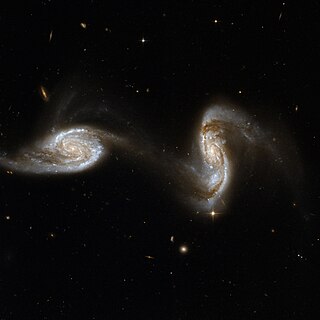 W
WArp 240 is a pair of interacting spiral galaxy located in the constellation Virgo. The two galaxies are listed together as Arp 240 in the Atlas of Peculiar Galaxies. The galaxy on the right is known as NGC 5257, while the galaxy on the left is known as NGC 5258. Both galaxies are distorted by the gravitational interaction, and both are connected by a tidal bridge, as can be seen in images of these galaxies.
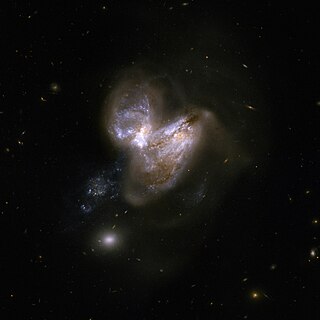 W
WArp 299 is a pair of colliding galaxies approximately 134 million light-years away in the constellation Ursa Major. Both of the galaxies involved in the collision are barred irregular galaxies.
 W
WArp 302 is a galaxy in the constellation Boötes. Arp 302, also known as VV 340 or UGC 9618 consists of a pair of very gas-rich spiral galaxies in their early stages of interaction. An enormous amount of infrared light is radiated by the gas from massive stars that are forming at a rate similar to the most vigorous giant star-forming regions in our own Milky Way. Arp 302 is 450 million light-years away from Earth, and is the 302nd galaxy in Arp's Atlas of Peculiar Galaxies.
 W
WFSC15307+3253 is an ultraluminous infrared galaxy (ULIRG), with a luminosity between 8 and 1000 µm of approximately 2×1013 L⊙, possibly the highest currently known. The "FSC" refers to Faint Source Catalogue, one of the source catalogs produced by the IRAS infrared survey mission. The emission is believed due to some combination of starburst activity and accretion onto a super-massive black hole, producing primary radiation at shorter wavelengths which is mostly blocked by obscuring dust, which is in turn heated and re-radiates in the infrared. The redshift of the source is z = 0.93, indicating a distance of the order of 7 billion light years.
 W
WHaro 11 (H11) is a small galaxy at a distance of 300,000,000 light-years (redshift z=0.020598). It is situated in the southern constellation of Sculptor. Visually, it appears to be an irregular galaxy, as the ESO image to the right shows. H11 is named after Guillermo Haro, a Mexican astronomer who first included it in a study published in 1956 about blue galaxies. H11 is a starburst galaxy that has 'super star clusters' within it and is one of nine galaxies in the local universe known to emit Lyman Continuum photons (LyC).
 W
WIC 883 is an irregular galaxy that is about 321 million light years away from Earth. It is located in the constellation Canes Venatici. Its largest radius is 1.4, and smallest 0.7 angular minutes. It was discovered by Rudolf Ferdinand Spitaler on May 1 1891. Also, in the backdrop of IC 883, there are hundreds of distant galaxies.
 W
WMarkarian 231 is a Type-1 Seyfert galaxy that was discovered in 1969 as part of a search of galaxies with strong ultraviolet radiation. It contains the nearest known quasar. Markarian 231 is located about 581 million light years away from Earth.
 W
WMayall's Object is the result of two colliding galaxies located 500 million light years away within the constellation of Ursa Major. It was discovered by American astronomer Nicholas U. Mayall of the Lick Observatory on 13 March 1940, using the Crossley reflector. When first discovered, Mayall's Object was described as a peculiar nebula, shaped like a question mark. Originally theorized to represent a galaxy reacting with the intergalactic medium, it is now thought to represent the collision of two galaxies, resulting in a new object consisting of a ring-shaped galaxy with a tail emerging from it. It is thought that the collision between the two galaxies created a shockwave that initially drew matter into the center which then formed the ring.
 W
WMessier 77 or M77, also known as NGC 1068, is a barred spiral galaxy about 47 million light-years away in the constellation Cetus. Messier 77 was discovered by Pierre Méchain in 1780, who originally described it as a nebula. Méchain then communicated his discovery to Charles Messier, who subsequently listed the object in his catalog. Both Messier and William Herschel described this galaxy as a star cluster. Today, however, the object is known to be a galaxy.
 W
WNGC 23 is a spiral galaxy located in the northern constellation of Pegasus, around 173.5 megalight-years distant from the Milky Way. It was discovered by William Herschel on 10 September 1784. In the Webb Society Deep-Sky Observer's Handbook, the visual appearance of NGC 23 is described as follows: Bright, extended ellipse; a bright nuclear structure is noticeably elongated; two weak spiral enhancements emerge from opposite sides of the nucleus, one curving towards a bright star attached on the south end. The galaxy is likely interacting with NGC 9.
 W
WNGC 17, also known as NGC 34, is a spiral galaxy in the constellation Cetus. It is the result of a merger between two disk galaxies, resulting in a recent starburst in the central regions and continuing starforming activity. The galaxy is still gas-rich, and has a single galactic nucleus. It lies 250 million light years away. It was discovered in 1886 by Frank Muller and then observed again later that year by Lewis Swift.
 W
WNGC 695 is a spiral galaxy located 450 million light years from the Earth, in the constellation of Aries. It has been described as an abnormal galaxy, and has the appearance of "a revolving tornado". Its arms are not tightly held together, and it is interacting with another small astronomical object. Despite its distance of nearly 0.5 billion lightyears, the galaxy's extremely luminous starburst disk, bright IR and UV emissions earned it a spot in the NGC catalogue. VLASS 1.2 survey images indicate the presence of extended radio emission in the core of the galaxy- indicative of either an active SMBH, nuclear starburst, or both.
 W
WNGC 877 is an intermediate spiral galaxy located in the constellation Aries. It is located at a distance of circa 160 million light years from Earth, which, given its apparent dimensions, means that NGC 877 is about 115,000 light years across. It was discovered by William Herschel on October 14, 1784. It interacts with NGC 876.
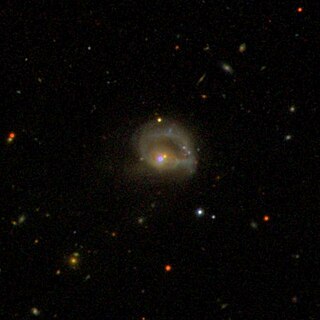 W
WNGC 985 is a ring galaxy in the constellation of Cetus. It is located about 550 million light years away from Earth, which means, given its apparent dimensions, that NGC 985 is approximately 160,000 light years across. It was discovered by Francis Leavenworth in 1886. It is a type 1 Seyfert galaxy.
 W
WNGC 1142 is a distorted spiral galaxy in the constellation of Cetus. It is located about 370 million light years away from Earth, which means, given its apparent dimensions, that NGC 1142 is approximately 170,000 light years across. It is a type 2 Seyfert galaxy. It interacts with the elliptical galaxy NGC 1141.
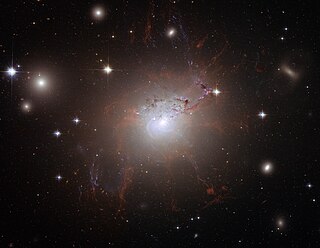 W
WNGC 1275 is a type 1.5 Seyfert galaxy located around 237 million light-years away in the direction of the constellation Perseus. NGC 1275 corresponds to the radio galaxy Perseus A and is situated near the center of the large Perseus Cluster of galaxies.
 W
WNGC 1365, also known as the Great Barred Spiral Galaxy, is a double-barred spiral galaxy about 56 million light-years away in the constellation Fornax.
 W
WNGC 1614 is the New General Catalogue identifier for a spiral galaxy in the equatorial constellation of Eridanus. It was discovered on December 29, 1885 by American astronomer Lewis Swift, who described it in a shorthand notation as: pretty faint, small, round, a little brighter middle. The nebula was then catalogued by Danish-Irish astronomer J. L. E. Drayer in 1888. When direct photography became available, it was noted that this galaxy displayed some conspicuous peculiarities. American astronomer Halton Arp included it in his 1966 Atlas of Peculiar Galaxies. In 1971, Swiss astronomer Fritz Zwicky described it as a "blue post-eruptive galaxy, compact patchy core, spiral plumes, long blue jet SSW".
 W
WNGC 1961 is a spiral galaxy in constellation Camelopardalis. It is at a distance of circa 200 million light years from Earth, which, given its apparent dimensions, means that NGC 1961 is more than 220,000 light years across. The galaxy has been distorted, however no companion has been detected nor double nuclei that could show a recent merger. Its outer arms are highly irregular. Two long straight arms extent from the north side of the galaxy. A luminous X-ray corona has been detected around the galaxy. NGC 1961 is the central member of the small group of nine galaxies, the NGC 1961 group.
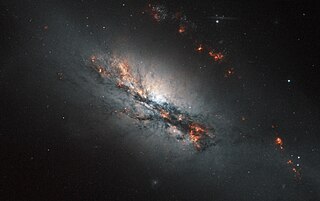 W
WNGC 2146 is a barred spiral galaxy type SB(s)ab pec in the constellation Camelopardalis. The galaxy was discovered in 1876 by Friedrich August Theodor Winnecke.
 W
WNGC 2623/Arp 243 is an interacting galaxy located in the constellation Cancer. NGC 2623 is the result of two spiral galaxies that have merged. Scientists believe that this situation is similar to what will occur to the Milky Way, which contains our solar system, and the neighboring galaxy, the Andromeda Galaxy in four billion years. Studying this galaxy and its properties have provided scientists with a better idea of the collision of the Milky Way and the Andromeda. Due to NGC 2623 being in the late stage of merging, the compression of the gas within the galaxy has led to a large amount of star formation, and to its unique structure of a bright core with two extending tidal tails.
 W
WNGC 3256 is a peculiar galaxy formed from the collision of two separate galaxies in the constellation of Vela. NGC 3256 is located about 100 million light years away and belongs to the Hydra-Centaurus supercluster complex. NGC 3256 provides a nearby template for studying the properties of young star clusters in tidal tails. The system hides a double nucleus and a tangle of dust lanes in the central region. The telltale signs of the collision are two extended luminous tails swirling out from the galaxy. The tails are studded with a particularly high density of star clusters. NGC 3256 is the most luminous galaxy in the infrared spectrum located within z 0.01 from Earth.
 W
WNGC 4194, the Medusa merger, is a pair of interacting galaxies in the constellation Ursa Major.
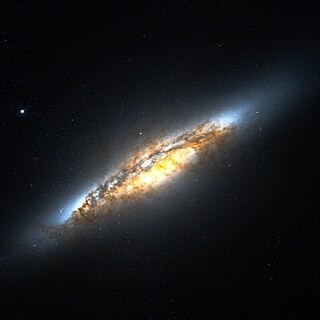 W
WNGC 5010 is a lenticular galaxy located about 140 million light years away, in the constellation Virgo. It is considered a LIRG. As the galaxy has few young blue stars and mostly red old stars and dust, it is transitioning from being a spiral galaxy to being an elliptical galaxy, with its spiral arms having burned out and become dusty arms.
 W
WNGC 5256 is a galaxy that contains two disc galaxies, that are colliding into each other. It is located in the constellation Ursa Major, and was discovered by William Herschel on 12 May 1787. The two nuclei of the galaxies are separated by about 13046.3 light years. NGC 5256 is located at about 350 million light years away from the earth.
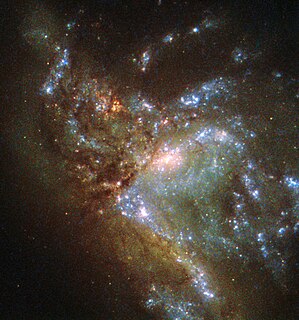 W
WNGC 6052 is a pair of galaxies in the constellation of Hercules. It was discovered on 11 June 1784 by William Herschel. It was described as "faint, pretty large, irregularly round" by John Louis Emil Dreyer, the compiler of the New General Catalogue.
 W
WNGC 6090 is a merging pair of spiral galaxies, 400 million light-years from the Earth, in the constellation of Draco. The cores of the two galaxies are around 10,000 light-years apart from each other, meaning that the merger is likely at its intermediate stage. Two large "tails", made of galactic material gravitationally ejected during the merger, have formed outside the main galaxies. Newly formed stars can be seen in the overlapping area.
 W
WNGC 6240 is a nearby ultraluminous infrared galaxy (ULIRG) in the constellation Ophiuchus. The galaxy is the remnant of a merger between three smaller galaxies. The collision between the three progenitor galaxies has resulted in a single, larger galaxy with two distinct nuclei and a highly disturbed structure, including faint extensions and loops.
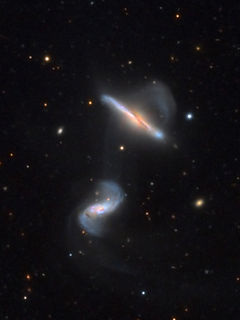 W
WNGC 6286 is an interacting spiral galaxy located in the constellation Draco. It is designated as Sb/P in the galaxy morphological classification scheme and was discovered by the American astronomer Lewis A. Swift on 13 August 1885. NGC 6286 is located at about 252 million light years away from Earth. NGC 6286 and NGC 6285 form a pair of interacting galaxies, with tidal distortions, categorized as Arp 293 in the Arp Atlas of Peculiar Galaxies.
 W
WNGC 6621 is an interacting spiral galaxy in the constellation Draco. It lies at a distance of circa 260 million light-years. NGC 6621 interacts with NGC 6622, with their closest approach having taken place about 100 million years before the moment seen now. The pair was discovered by Edward D. Swift and Lewis A. Swift on June 2, 1885. Originally NGC 6621 was assigned to the southeast galaxy, but now it refers to the northern one. NGC 6621 and NGC 6622 are included in the Atlas of Peculiar Galaxies as Arp 81 in the category "spiral galaxies with large high surface brightness companions".
 W
WNGC 6670 is a pair of interacting galaxies within the Draco constellation, which lie around 401 million light-years from Earth. Its shape resembles a leaping dolphin. NGC 6670 was discovered by Lewis A. Swift on July 31, 1886. NGC 6670 is a combination of two colliding disc galaxies which are known as NGC 6670E and NGC 6670W. The galaxy is 100 billion times brighter than our Sun. The galaxies have already collided once before and they are now moving towards each other again nearing a second collision. Its apparent magnitude is 14.3, its size is 1.0 arc minutes.
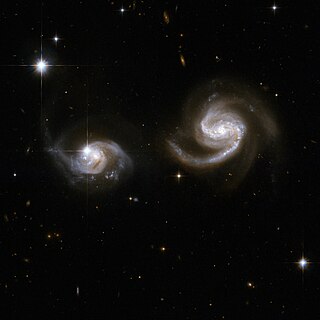 W
WNGC 6786 is an interacting spiral galaxy 350 million light years from the Earth, in the constellation of Draco. In 2004, a supernova occurred inside the galaxy. NGC 6786 is currently interacting with LEDA 62867, and, being the larger galaxy, it is likely that NGC 6786 will absorb LEDA 62867 in the future. Both galaxies appear to be undergoing a starburst, a phenomenon commonly seen among interacting and merging galaxies.
 W
WNGC 6907 is a spiral galaxy located in the constellation Capricornus. It is located at a distance of circa 120 million light years from Earth, which, given its apparent dimensions, means that NGC 6907 is about 115,000 light years across. It was discovered by William Herschel on July 12, 1784. The total infrared luminosity of the galaxy is 1011.03 L☉, and thus it is categorised as a luminous infrared galaxy.
 W
WNGC 7130 is a spiral galaxy located in the constellation Piscis Austrinus. It is located at a distance of circa 220 million light years from Earth, which, given its apparent dimensions, means that NGC 7130 is about 100,000 light years across. It was discovered by John Herschel on September 25, 1834, and discovered independently by Lewis Swift on September 17, 1897. The location of the galaxy given in the New General Catalogue was off by 30 arcminutes in declination from the location of the galaxy.
 W
WNGC 7469 is an intermediate spiral galaxy in the constellation of Pegasus. NGC 7469 is located about 200 million light years away from Earth, which means, given its apparent dimensions, that NGC 7469 is approximately 90,000 light years across. It was discovered by William Herschel on November 12, 1784.
 W
WNGC 7552 is a barred spiral galaxy in the constellation Grus. It is at a distance of circa 60 million light years from Earth, which, given its apparent dimensions, means that NGC 7552 is about 75,000 light years across. It forms with three other spiral galaxies the Grus Quartet.
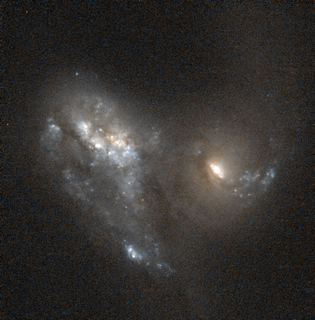 W
WNGC 7592 is an interacting galaxy system located 300 million light years away in the constellation Aquarius. It was discovered by William Herschel on September 20, 1784. The total infrared luminosity is 1011.33 L☉, and thus it is categorised as a luminous infrared galaxy. One of the galaxies hosts a type 2 Seyfert nucleus.
 W
WNGC 7674 is a spiral galaxy located in the constellation Pegasus. It is located at a distance of circa 350 million light years from Earth, which, given its apparent dimensions, means that NGC 7674 is about 125,000 light years across. It was discovered by John Herschel on August 16, 1830.
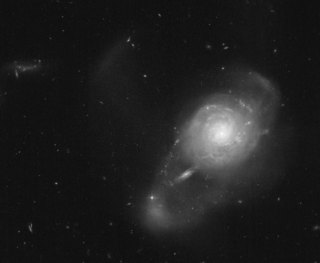 W
WNGC 7679 is a lenticular galaxy with a peculiar morphology in the constellation Pisces. It is located at a distance of circa 200 million light years from Earth, which, given its apparent dimensions, means that NGC 7679 is about 60,000 light years across. It was discovered by Heinrich d'Arrest on September 23, 1864. The total infrared luminosity is 1011.05 L☉, and thus it is categorised as a luminous infrared galaxy. NGC 7679 is both a starburst galaxy and a Seyfert galaxy.
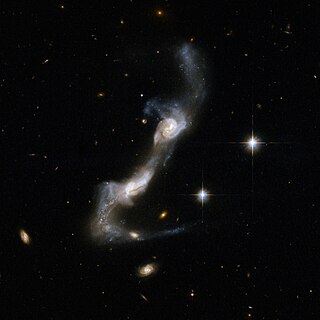 W
WUGC 8335 is a pair of strongly interacting spiral galaxies. They have been distorted by extreme tidal forces, creating prominent tidal tails and a bridge of gas and stars between the galaxies.
 W
WWISE J224607.57−052635.0 (or W2246−0526 for short) is an extremely luminous infrared galaxy (ELIRG) which, in 2015, was announced as the most luminous known galaxy in the Universe. The brightness is 350 trillion times that of the Sun (349×1012L☉), and the merger of smaller nearby galaxies may be contributing to its brightness. The light is generated by a quasar 10 billion times the mass of the Sun. The optical and ultraviolet light emitted by the accretion disc around the quasar's supermassive black hole is absorbed by the galaxy's dust and remitted in the infrared. The galaxy releases 10,000 times more energy than the Milky Way galaxy, although WISE J224607.57–052635.0 is the smaller of the two. WISE J224607.57–052635.0 has a light-travel distance of 12.5 billion light-years from it to Earth. The galaxy was discovered using the Wide-field Infrared Survey Explorer.
 W
WThe object ZW II 96 is a pair of galaxies that are merging. It is located in the constellation Delphinus, about 500 million light-years away from Earth.